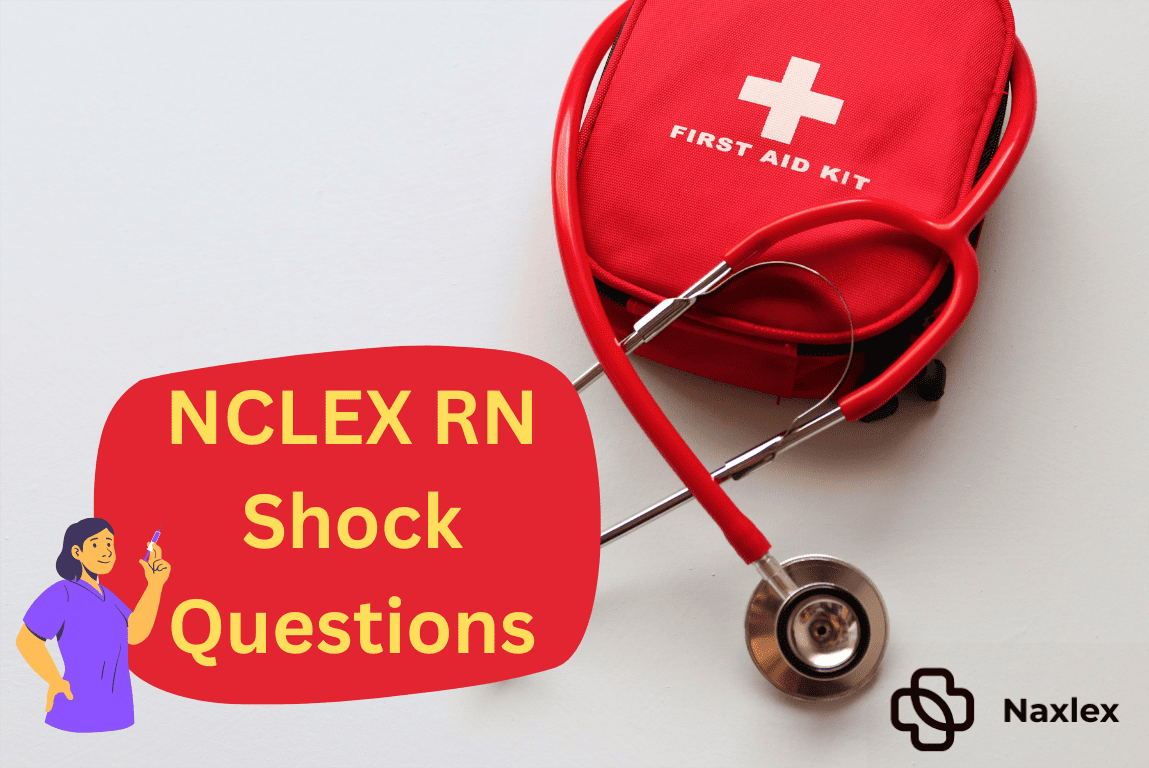Free NCLEX 14-day Free Trial
Try some exam questions on the NCLEX!
NCLEX RN Shock Questions
Shock consists of various subtypes, each stemming from distinct causes yet sharing common features, such as low blood pressure and insufficient tissue perfusion explored in NCLEX RN Shock Questions. Nursing interventions play a vital role in treating shock patients. In most cases, shock treatment falls into the nurses' responsibility, such as monitoring vital signs, oxygen administration, fluid administration and providing the patient with supportive care. That's why NCLEX RN students should prepared to identify shock and recognize its early stage.
Prepare effectively for your NCLEX RN shock questions with the comprehensive Naxlex NCLEX RN practice test. Specifically, tailored shock questions offer invaluable insight into the exam format, ensuring you're well-prepared for the actual test.
Despite the challenge many nursing students face with the exam, Naxlex NCLEX RN shock questions provide a solution with its predictive preliminary test, boasting a remarkable 99% accuracy rate. With Naxlex NCLEX, you can confidently aim for a 90% or above score on your first attempt, setting yourself up for success in your nursing career. Don't leave your exam success to chance—trust Naxlex for your NCLEX RN shock questions preparation.

What causes Shock?
Shock can be caused by several factors that lead to reduced tissue perfusion.
There are several classes of shock, including:
- Hypovolemic shock arises from insufficient blood volume to supply tissues with blood properly. The primary form, known as hemorrhagic shock, occurs because of excessive bleeding caused by ulcers, trauma or other factors leading to blood loss. Additionally, severe dehydration can also trigger hypovolemic shock by causing a lack of water in the body, thereby compromising blood pressure even without actual blood loss.
- Distributive shock occurs when blood fails to reach its intended destination due to an abnormal distribution pattern. This atypical situation can result from various factors, including other forms of shock.
- Obstructive shock is a distinct form characterized by the inability of tissues to be adequately perfused due to an obstruction hindering blood flow, such as a blood clot.
- Cardiogenic shock occurs when the heart, a vital organ responsible for circulating oxygenated blood throughout the body, fails to pump sufficient blood to sustain tissue function. This condition typically stems from a heart-related issue or injury, such as a heart attack.
- Anaphylactic shock: it arises from an intense allergic reaction, triggering the dilation of blood vessels and a subsequent drop in blood pressure. Furthermore, the allergens can prompt excessive fluid accumulation in tissues, resulting in swelling and further blood pressure and volume reductions.
- Neurogenic shock occurs due to a disruption in communication between the sympathetic nervous system and the blood vessels it regulates. Typically, the nervous system helps regulate blood pressure by adjusting blood vessel tone. However, blood vessels relax and widen when this communication breaks down, significantly decreasing blood pressure. Damage to the spinal cord is the most frequent cause of neurogenic shock.
- Septic shock: this is triggered by a widespread infection that poses a significant threat to life if not promptly addressed. This infection can lead to numerous small blood clots that impede tissue perfusion.
Read More
Naxlex NCLEX RN shock Questions
- A patient presents to the emergency department with symptoms of shock, including tachycardia, hypotension, and cool, clammy skin. The nurse suspects hypovolemic shock because of potential blood loss. What steps should the nurse take to confirm this diagnosis and initiate appropriate treatment?
Answer:
The nurse should begin by assessing the patient's vital signs, obtaining a detailed medical history, and performing a physical examination to identify any signs of bleeding or trauma. Laboratory tests, including complete blood count, coagulation studies, and blood typing and crossmatching, should be ordered to assess the presence and severity of blood loss. Additionally, diagnostic imaging such as ultrasound or computed tomography may be indicated to locate potential sources of bleeding. Once the diagnosis of hypovolemic shock is confirmed, the nurse should initiate rapid fluid resuscitation with isotonic crystalloid solutions, monitor the patient's response closely, and collaborate with the healthcare team to address the underlying cause of bleeding.
- Which of the following are potential treatments for septic shock? Select all that apply.
A) Antibiotics
B) Intravenous fluids
C) Vasopressor medications
D) Antihistamines
Answer: A) Antibiotics, B) Intravenous fluids, C) Vasopressor medications
Explanation: Treatment for septic shock typically involves antibiotics to address the underlying infection, intravenous fluids to restore blood volume, and vasopressor medications to support blood pressure. Antihistamines are not used in the treatment of septic shock.
Check out: NCLEX Retake - Explained
- Which of the following are common signs and symptoms of hypovolemic shock? Select all that apply.
A) Rapid heart rate
B) Low blood pressure
C) Increased urine output
D) Pale, cool, clammy skin
Answer: A) Rapid heart rate, B) Low blood pressure, D) Pale, cool, clammy skin
Explanation: Hypovolemic shock is characterized by a rapid heart rate, low blood pressure, and pale, cool, clammy skin due to decreased blood volume.
Final Thought
Empower your NCLEX RN shock exam preparation with Naxlex's NCLEX RN shock questions and exceptional practice resources. These targeted questions offer valuable insights into the exam's content and structure, giving you an edge in your preparation efforts. While it's common for nursing students to fail the NCLEX exam, Naxlex NCLEX RN provides a reliable solution with its highly accurate preliminary test, designed to predict the exam with 99% precision. With Naxlex's comprehensive NCLEX prep materials, you can confidently strive for a stellar score of 95% or higher on your first attempt, paving the way for a successful nursing career—Trust Naxlex NCLEX to guide you toward exam success and achieve your professional goals.
Check out Naxlex LPN Study Guide.
Pre-register for our Upcoming NCLEX Program. The top and most trusted Nclex prep that's accurate as the actual exam.
- Content Created by over 600 nursing students who have sat for NCLEX. (in person)
- Reviewing over 3000 Flawless responses shared by NCLEX exam takers
- Creating questions from the most tested areas to exact repeated questions
- Creating a study guide on most common tested areas
- Over 3000 Qbanks with well explained rationale, with our approach focusing on sata, priority questions and NGN questions.
- Easy to use interface, unlimited CATs just like NCLEX, unlimited readiness tests.
- Sure pass guarantee on first time.
Turn on notifications and get daily updates on when we shall be going live.

